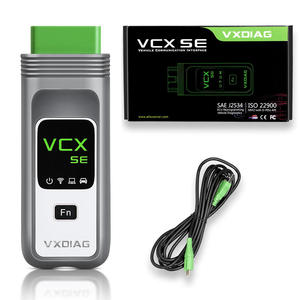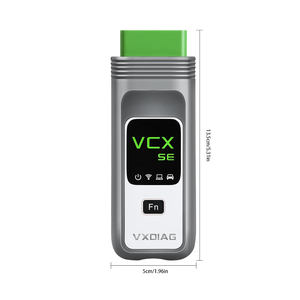(43768 products available)














































































































































































































There are numerous options for car diagnostic tools, each with its own set of features and capabilities. Below are some popular categories:
Handheld Diagnostic Scanner
These are small, portable devices that are easy to use. They can read and clear trouble codes and perform basic diagnostics. They are usually less expensive and offer limited functionality compared to other types.
Professional Diagnostic Scanner
These are advanced diagnostic tools that automotive professionals use. They have many features, such as live data streaming, advanced coding, and special function capabilities. They can perform comprehensive diagnostics on multiple systems and coverage for many car makes and models.
OBD2 Bluetooth Scanner
Bluetooth OBD2 scanners connect to a car's OBD2 port and sync wirelessly with a smartphone or tablet. They allow vehicle diagnostics through a dedicated mobile app. They are versatile and often used for DIY diagnostics and basic health checks. Their functionality depends on the specific model and the app's capabilities.
OEM Dealer Tool
These are diagnostic tools developed by the original equipment manufacturer (OEM) for use by dealers. They provide full diagnostic and programming capabilities tailored to that brand's vehicles. They can access all systems, perform key programming, and update the software. The tools are usually expensive and require a subscription to use.
Multi-brand Diagnostic Tool
These tools are designed for vehicles from many different brands. They offer a wide range of diagnostic functions and software updates. They are suitable for workshops and diagnostic service providers who handle multiple makes and models.
Specialized Diagnostic Tool
These are diagnostic tools designed for a specific system or component, such as the engine, transmission, or ABS. They provide in-depth analysis and troubleshooting for specialized areas. They are helpful for repair shops and service centers that need advanced diagnostics for particular systems.
Various car diag tools have different specifications that cater to specific needs. Below are some common specifications to look out for.
Diagnostic Coverage
Some tools cover more car models than others. A car diag tool with a wider diagnostic range is more useful.
Functionality
Some tools can only read codes and others can read, live data, perform actuation tests and special functions.
Display
Some tools have a colour LCD display while others have a monochrome display.
Power Source
Some tools are powered by the vehicle’s OBD port and others have an internal rechargeable battery.
Size and Portability
Some car diag tools are handheld while others are tablet-sized. Handheld tools are more portable.
Compatibility
Some tools are compatible with specific operating systems like Windows, Android, or iOS. This allows for software updates and data management.
Car diag tools are important investments and must be maintained regularly to prolong their lives. Below are car diag tool maintenance tips.
Follow Manufacturer Instructions
Users should read and follow the manufacturer's instructions on maintenance and care of the tool.
Regular Updates
Users should regularly update their car diag tool software to maintain compatibility and optimal performance.
Cleanliness
Users should keep their diagnostic tools clean and free from dust, dirt and debris.
Proper Storage
When not in use, users should store the diagnostic tool in a clean, dry environment, away from direct sunlight and extreme temperatures.
Avoid Drops
Users should be careful not to drop or subject the diagnostic tool to physical stress, as this can damage its internal components.
Check Cables and Connectors
Users should frequently check the cables and connectors for any signs of wear, fraying, or damage and replace them if necessary.
Battery Care
If the car diag tool has a rechargeable battery, users should recharge it according to the manufacturer's instructions and avoid overcharging or deep discharging it.
Regular Functionality Check
Users should regularly check that the car diag tool is functioning properly and that all components are working well.
With so many options available, choosing the right car diagnostic tool can be a daunting task. Here are some factors to consider when choosing a car diagnostic tool:
Some complicated car diag tools cannot be replaced at home. However, some can be replaced at home. It is essential to note the manufacturer's instructions on the package. Here are some general instructions on how to replace a car diag tool.
Identify the tool
Find out what diag tool is being used in the car. Is it the OBD2 scanner, the diagnostic software, or the mobile app that needs to be replaced?
Check compatibility
Ensure that the new diagnostic tool is compatible with the car's make, model, and year.
Update software
If the tool being replaced is a diagnostic scanner, ensure the software is updated to the latest version. This ensures it has the latest bug fixes and improvements.
Connect properly
For tools that connect to a port (like OBD2), ensure they are connected securely and completely to avoid any connection issues. If there are any loose connections, the tool will not work properly.
Follow instructions
Every diagnostic tool comes with a manual. Follow the instructions provided by the manufacturer for installation, usage, and any necessary updates. The instructions act as a guide to help the user know what to do.
Test functionality
After replacement, start the car and run tests to ensure the diagnostic tool functions properly. Ensure it reads codes, communicates with the car's systems, and performs necessary diagnostics. If it does not perform the necessary diagnostics, then something is wrong with the tool or the connections.
Check for updates
If the tool being used is a software application, check online for updates or new versions. Download and install them according to the manufacturer's instructions. This keeps the tool current with the latest features and fixes.
Seek professional assistance
If unsure about the replacement process or if the new tool is working correctly, consult a professional mechanic or technician. They have experience and can ensure everything is done correctly.
Q1: Can a car diag tool drain a car battery?
A1: Some car diag tools can drain a car battery, especially if used for extended periods. It is always advisable to ensure the battery has a good charge before using a diagnostic tool extensively.
Q2: Is it easy to use a car diag tool?
A2: Generally, diagnostic tools are designed to be user-friendly with intuitive interfaces. Besides, some have guided prompts to make fault finding easy. Furthermore, some diagnostic tools are designed to be user-friendly with intuitive interfaces?
Q3: Can a car diag tool fix a check engine light?
A3: A car diag tool can identify and let the user know the error code causing the check engine light to display. It can also read and clear the codes. However, it cannot physically fix the underlying issue, which can only be done by a mechanic.
Q4: Can a car diag tool be used on all cars?
A4: Some car diag tools are designed to be used on all cars, while others are only compatible with specific makes or models. It is important to check the compatibility information before purchasing a car diag tool.
The keyword "car diag tool" maintains a consistent average monthly web search volume of 10, showing no significant changes over the past year or three months. This stability is reflected in the steady monthly search figures from December 2023 through November 2024, each month recording exactly 10 web searches.
This consistent web search volume for "car diag tool" suggests a stable interest level among vehicle owners and professionals in the automotive sector who require diagnostic tools. The lack of fluctuations or seasonal variations indicates that the demand for these tools is steady and not influenced by specific times of the year, which might be expected for other automotive products.
The persistent web search volume without any spikes or drops points to a niche but dedicated user base. This could imply that while the market for car diagnostic tools is not expanding rapidly, it also isn't shrinking. The consistent figures may reflect a satisfied user group that doesn't need to search frequently, indicating a product that meets their needs without requiring repeated research or comparison shopping.